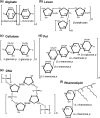Pseudomonas biofilm matrix composition and niche biology
- PMID: 22212072
- PMCID: PMC4409827
- DOI: 10.1111/j.1574-6976.2011.00322.x
Pseudomonas biofilm matrix composition and niche biology
Abstract
Biofilms are a predominant form of growth for bacteria in the environment and in the clinic. Critical for biofilm development are adherence, proliferation, and dispersion phases. Each of these stages includes reinforcement by, or modulation of, the extracellular matrix. Pseudomonas aeruginosa has been a model organism for the study of biofilm formation. Additionally, other Pseudomonas species utilize biofilm formation during plant colonization and environmental persistence. Pseudomonads produce several biofilm matrix molecules, including polysaccharides, nucleic acids, and proteins. Accessory matrix components shown to aid biofilm formation and adaptability under varying conditions are also produced by pseudomonads. Adaptation facilitated by biofilm formation allows for selection of genetic variants with unique and distinguishable colony morphology. Examples include rugose small-colony variants and wrinkly spreaders (WS), which over produce Psl/Pel or cellulose, respectively, and mucoid bacteria that over produce alginate. The well-documented emergence of these variants suggests that pseudomonads take advantage of matrix-building subpopulations conferring specific benefits for the entire population. This review will focus on various polysaccharides as well as additional Pseudomonas biofilm matrix components. Discussions will center on structure-function relationships, regulation, and the role of individual matrix molecules in niche biology.
© 2011 Federation of European Microbiological Societies. Published by Blackwell Publishing Ltd. All rights reserved.
Figures





References
-
- Abel MH, Bass FG, Krane EJ, Thomas AL, Liggins GC. Pituitary stalk-section and some of its effects on endocrine function in the fetal lamb. Q J Exp Physiol Cogn Med Sci. 1978;63:211–219. - PubMed
-
- Alhede M, Bjarnsholt T, Jensen PO, et al. Pseudomonas aeruginosa recognizes and responds aggressively to the presence of polymorphonuclear leukocytes. Microbiology. 2009;155:3500–3508. - PubMed
Publication types
MeSH terms
Substances
Grants and funding
LinkOut - more resources
Full Text Sources
Other Literature Sources

